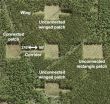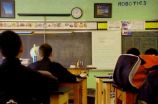(Press-News.org) ANN ARBOR—Inspired by the space physics behind solar flares and the aurora, a team of researchers from the University of Michigan and Princeton has uncovered a new kind of magnetic behavior that could help make nuclear fusion reactions easier to start.
Fusion is widely considered the ultimate goal of nuclear energy. While fission leaves behind radioactive waste that must be stored safely, fusion generates helium, a harmless element that is becoming scarce. Just 250 kilograms of fusion fuel can match the energy production of 2.7 million tons of coal.
Unfortunately, it is very difficult to get a fusion reaction going.
"We have to compress the fuel to a temperature and density similar to the core of a star," said Alexander Thomas, assistant professor of nuclear engineering and radiological sciences.
Once those conditions are reached, the hydrogen fuel begins to fuse into helium. This is how young stars burn, compressed by their own gravity.
On Earth, it takes so much power to push the fuel atoms together that researchers end up putting in more energy than they get out. But by understanding a newly discovered magnetic phenomenon, the team suggests that the ignition of nuclear fusion could be made more efficient.
Two methods dominate for confining the fuel, made of hydrogen atoms with extra neutrons, so that fusion can begin. Magnetic confinement fusion uses magnetic fields to trap the fuel in a magnetic 'bottle,' and inertial confinement fusion heats the surface of the fuel pellet until it blows off in a way that causes the remaining pellet to implode. The team explored an aspect of the latter method through computer simulations.
"One of the concerns with nuclear fusion is to squeeze this very spherical fuel pellet perfectly into a very small spherical pellet," said Archis Joglekar, a doctoral student in nuclear engineering and radiological sciences.
To avoid pushing the ball of fuel into an irregular shape that won't ignite, the fuel must be exposed to uniform heat that will cause its surface layer to evaporate all at once. As this layer pushes off at high speed, it applies equal pressure to all sides of the pellet and causes it to shrink to one thousandth of its original volume. When that happens, the fuel begins to fuse.
Joglekar calls even heating "the biggest concern in terms of achieving inertial confinement fusion."
The heat comes from about 200 laser beams hitting the inside of a hollow metal cylinder with the fuel pellet sitting at its heart. The trouble is that the light energy from the laser is converted to heat in the metal by way of electrons, and the electrons can get trapped in magnetic fields created by the laser spots.
When the laser light hits the metal, it turns some of the surface metal into plasma, or a soup of electrons and free atomic nuclei. The laser and the heat drive the electrons to move in a way that sets up a magnetic field circling the laser spot.
The magnetic field acts as a boundary for the electrons—they can't cross it. But until now, researchers didn't know that the hot electrons, in an effort to get to cooler areas, are able to push the magnetic fence outward.
The team showed that the flow of hot electrons could drive the magnetic fields around neighboring laser spots together, causing them to join up. Instead of forming a barrier between the laser spots, the joined fields open a channel between them.
"Now there's a clear path for the electrons to move into what would otherwise be the cold region," Joglekar said.
Designers of inertial fusion ignition systems may be able to use this newly discovered feature to place the laser spots so that they heat the cylinder more quickly and efficiently.
"Essentially, what we found is a completely new magnetic reconnection mechanism," Thomas said. "Though we're studying it in an inertial confinement fusion process, it might be relevant to the surface of the sun and magnetic confinement fusion."
For instance, knowing that the flow of hot, charged particles on the sun can push magnetic fields around could inspire new theories about how solar flares occur.
INFORMATION:
A paper on this work, titled "Magnetic reconnection in plasma under inertial confinement fusion conditions driven by heat flux effects in Ohm's law," is published in Physical Review Letters. It was carried out in collaboration with Amativa Bhattacharjee and William Fox of the Princeton Plasma Physics Laboratory.
Alexander Thomas: http://www.engin.umich.edu/ners/people/faculty/alexander-thomas
Abstract: https://journals.aps.org/prl/abstract/10.1103/PhysRevLett.112.105004
Magnetic behavior discovery could advance nuclear fusion
2014-03-19
ELSE PRESS RELEASES FROM THIS DATE:
Increased risk of relapse omitting RT in early PET scan negative Hodgkin lymphoma
2014-03-19
Interim analysis of the intergroup EORTC-LYSA-FIL 20051 H10 trial published in the Journal of Clinical Oncology indicates an increased risk of early relapse when omitting radiotherapy in early PET scan negative patients with stage I/II Hodgkin's lymphoma. Early outcome, however, was excellent in both arms, and the final analysis should reveal whether these initial findings are maintained over time.
Dr. J.M.M. Raemaekers of the Radboud university medical center Nijmegen, The Netherlands, and central coordinator of the study says, "The standard treatment for patients with ...
Study finds forest corridors help plants disperse their seeds
2014-03-19
A forest in South Carolina, a supercomputer in Ohio and some glow-in-the-dark yarn have helped a team of field ecologists conclude that woodland corridors connecting patches of endangered plants not only increase dispersal of seeds from one patch to another, but also create wind conditions that can spread the seeds for much longer distances.
The idea for the study emerged from modern animal conservation practices, where landscape connectivity – the degree to which landscapes facilitate movement – is being used to counteract the impacts of habitat loss and fragmentation ...
Inflammation mobilizes tumor cells
2014-03-19
Researchers of Ludwig-Maximilians-Universitaet (LMU) in Munich have discovered a novel feedback mechanism that provides a mechanistic link between chronic inflammation and carcinogenesis.
Malignant tumors pose a major threat to survival largely because they shed mobile cells that can form secondary tumors in other tissues. This process requires a fundamental change in the character of cells within the primary tumor, insofar as members of a localized cell mass must be converted into actively migrating cells that invade into the surrounding tissue and blood vessels, and ...
IU, Regenstrief study: New noninvasive colorectal cancer screening tool highly accurate
2014-03-19
INDIANAPOLIS -- An Indiana University and Regenstrief Institute study of nearly 10,000 average-risk, asymptomatic men and women from 90 sites across the United States reports that a multi-target stool DNA test -- a new noninvasive colorectal cancer screening tool that has not yet been approved for sale by the Food and Drug Administration -- detects 92.3 percent of colon cancers, compared to only 73.8 percent of cancers detected by a fecal immunochemical test, the most commonly used noninvasive test today.
Study results were published online March 19 and in the April ...
Earliest evidence of limb bone marrow in the fin of a 370 million year old fish
2014-03-19
This week in the journal Proceedings of the Royal Society B, a team of French and Swedish researchers present the earliest fossil evidence for the presence of bone marrow in the fin of a 370 million-year-old fish.
Long bones, which are found in the limb of tetrapods, are not only important for locomotion and supporting the weight of the body, but also host the bone marrow. The latter plays a major role in haematopoiesis, i.e. the formation of blood cells. In a healthy adult human, about a hundred billion to one trillion new blood cells are produced every day to maintain ...
Internists must play a larger role in managing menopausal symptoms
2014-03-19
New Rochelle, NY, March 19, 2014—The number of menopausal women is projected to reach 50 million by 2020. With changing views on appropriate therapies to control symptoms and new treatments available and on the horizon, most internists lack the core competencies and experience to meet the needs of women entering menopause, according to a provocative Commentary published in Journal of Women's Health, a peer-reviewed publication from Mary Ann Liebert, Inc., publishers. The article is available free on the Journal of Women's Health website at http://www.liebertpub.com/jwh.
The ...
Genetic test could improve colon cancer screening
2014-03-19
A non-invasive test that includes detection of the genetic abnormalities related to cancer could significantly improve the effectiveness of colon cancer screening, according to research published by a team of scientists including David Ransohoff, MD, professor of medicine at the UNC School of Medicine and UNC Lineberger Comprehensive Cancer Center member. The large-scale, cross-sectional study was published online today in The New England Journal of Medicine.
The study compared two different types of tests used for screening colorectal cancer: a non-invasive, multitarget ...
Strategies for teaching common core to teens with autism show promise
2014-03-19
Scientists at UNC's Frank Porter Graham Child Development Institute (FPG) report that high school students with autism can learn under Common Core State Standards (CCSS), boosting their prospects for college and employment. Newly published recommendations from FPG's team also provide strategies for educating adolescents with autism under a CCSS curriculum.
"The number of students with autism who enter high school settings continues to grow," said Veronica P. Fleury, lead author and postdoctoral research associate with FPG's Center on Secondary Education for Students with ...
New technique makes LEDs brighter, more resilient
2014-03-19
Researchers from North Carolina State University have developed a new processing technique that makes light emitting diodes (LEDs) brighter and more resilient by coating the semiconductor material gallium nitride (GaN) with a layer of phosphorus-derived acid.
"By coating polar GaN with a self-assembling layer of phosphonic groups, we were able to increase luminescence without increasing energy input," says Stewart Wilkins, a Ph.D. student at NC State and lead author of a paper describing the work. "The phosphonic groups also improve stability, making the GaN less likely ...
Chemo-free treatment a possibility for leukemia/lymphoma
2014-03-19
Patients with terminal forms of leukaemia and lymphoma who have run out of treatment options could soon benefit from a new drug, which not only puts an end to chemotherapy and has virtually no side effects but also improves a patient's life expectancy and quality of life.
It has been described as a breakthrough in cancer treatment by a leading professor in haematology, who presented the findings of the Phase 1 trial at an international conference in New Orleans in December 2013.
Professor Simon Rule, Consultant Haematologist at Plymouth Hospitals NHS Trust and researcher ...





